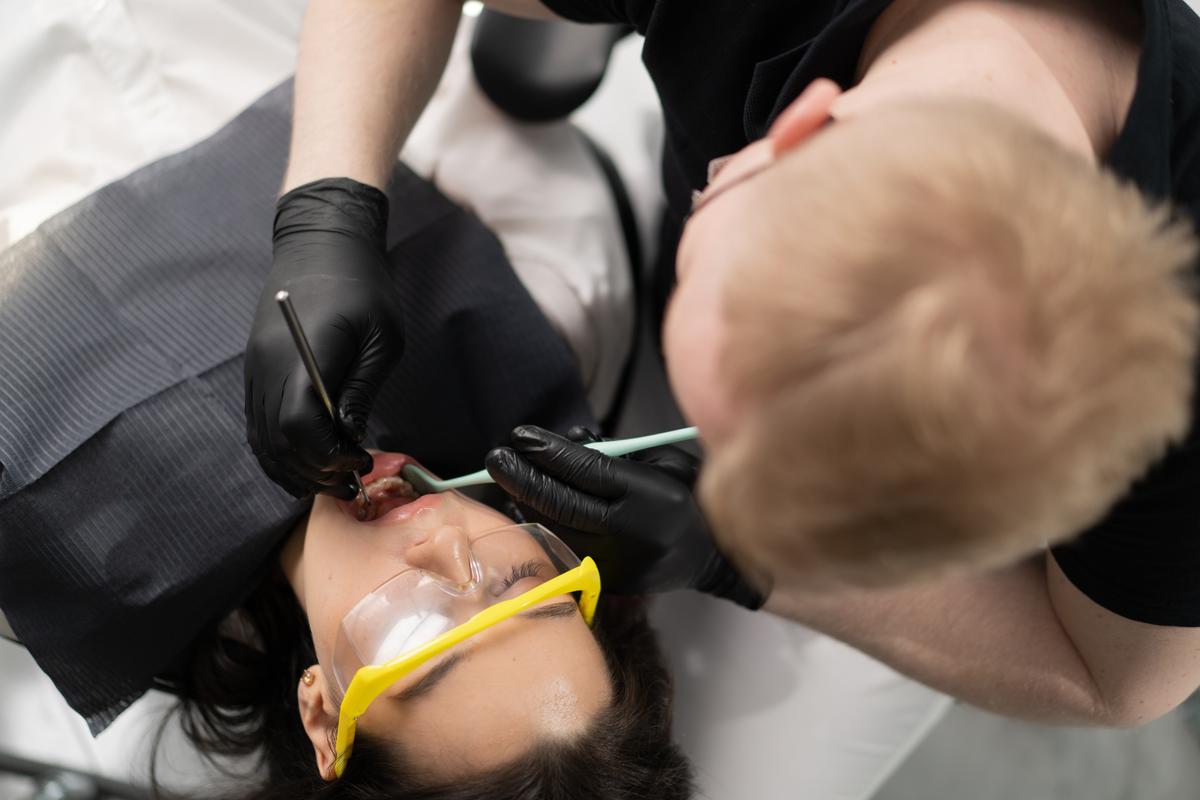Introduction
Gap between teeth, often referred to as diastemas, can occur for a variety of reasons. These spaces may be present from childhood and can persist into adulthood, or they may develop later due to factors such as tooth loss, misalignment, or changes in the jaw structure. Understanding the underlying causes of these gaps is essential for determining whether treatment is necessary. While some individuals may choose to embrace their natural smile, others may feel self-conscious about the appearance of gaps, leading to a desire for corrective measures.
The aesthetics of a person’s smile can significantly impact their self-esteem and confidence. In some cases, gaps between teeth can also affect oral health. For instance, large gaps can create areas where food can get trapped, increasing the risk of decay and gum disease. Additionally, gaps can sometimes lead to bite issues, which may cause discomfort or further dental complications over time.
Importance of Understanding When Treatment is Necessary
Determining when treatment for a gap between teeth is necessary involves careful consideration of various factors. It is crucial to assess the size and location of the gap, as well as its impact on both the individual’s aesthetic preferences and oral health. If a gap is small and not causing any functional issues or discomfort, many people may opt to leave it untreated. However, if the gap is significant and leads to problems such as shifting teeth or bite misalignment, seeking professional advice becomes important.
Consulting with a dental professional can provide clarity on whether a teeth gap treatment is advisable. They can evaluate the gap and recommend the most appropriate treatment options, which may include orthodontic solutions like braces or clear aligners, cosmetic procedures such as veneers or bonding, or a combination of approaches. Ultimately, understanding the necessity of treatment is not just about aesthetics; it is also about ensuring long-term oral health and preventing potential complications that may arise from untreated gaps. Therefore, individuals should feel empowered to seek professional advice to make informed decisions about their dental care.
Understanding Gaps Between Teeth

Definition and Types of Gaps
Gap between teeth, commonly referred to as diastemas, can be a significant concern for many individuals. Diastema specifically denotes a space or gap that occurs between two teeth, often found in the front of the mouth. This gap can vary in size, ranging from a subtle space that is hardly noticeable to a more pronounced opening that can affect one’s smile and confidence. Another type of spacing, often referred to in dental terms, is general spacing. This occurs when there are larger gaps between multiple teeth, which can result from a variety of factors, including tooth size discrepancies or jaw size relative to teeth.
Common Causes of Gaps Between Teeth
Understanding the common causes of gaps between teeth is essential for determining whether treatment is necessary. Several factors contribute to the development of these spaces. One of the most prevalent causes is genetics; some individuals are simply predisposed to having larger gaps due to the size and shape of their teeth or jaw structure. Another significant cause is tooth loss, which can create gaps in the dental arch. This can happen due to decay, trauma, or periodontal disease.
Additionally, improper dental alignment can lead to spacing issues. When teeth do not erupt correctly, they can drift apart, creating gaps. Habits such as thumb sucking, prolonged pacifier use, or even dental grinding can also play a role in the development of diastemas. Furthermore, certain medical conditions, such as gum disease, can affect the structure and positioning of teeth, resulting in gaps.
How Gaps Can Affect Dental Health and Aesthetics
While gaps between teeth can have aesthetic implications, they can also pose potential health risks. From a cosmetic standpoint, individuals with noticeable gaps may feel self-conscious about their smile, leading to decreased confidence and social anxiety. This can affect their willingness to smile, laugh, or engage in social situations.
rom a dental health perspective, gaps can create environments that are conducive to plaque and food accumulation. Spaces between teeth may hinder effective cleaning, making it easier for plaque to build up and potentially leading to tooth decay and gum disease. Moreover, gaps can affect how teeth bite together, which can result in uneven wear or jaw pain over time. In some cases, gaps can also contribute to shifting teeth, further exacerbating alignment issues and complicating oral health.
In conclusion, understanding the definition, types, common causes, and potential impacts of gaps between teeth is crucial for individuals considering teeth gap treatment. By identifying these aspects, one can better evaluate the necessity of treatment and explore the various options available to address gaps in their smile.
Evaluating the Need for Treatment

Impact on Oral Health
One significant aspect to evaluate is the impact on oral health. Gaps can lead to bite issues, where the misalignment of teeth affects how they fit together. This misalignment can result in difficulty chewing, discomfort, and even temporomandibular joint (TMJ) disorders, which can manifest as jaw pain and headaches. Furthermore, gaps between teeth can create spaces that trap food particles and plaque, increasing the risk of gum disease. Bacteria can flourish in these areas, leading to inflammation, gingivitis, and potentially more severe periodontal issues if left untreated. The health of your gums and teeth is paramount, and any signs of distress should not be overlooked.
Emotional and Psychological Effects
In addition to physical health concerns, the emotional and psychological effects of having a gap between teeth can be profound. Individuals may feel self-conscious about their smile, which can lead to a decrease in confidence and social interactions. The visibility of a gap can affect one’s willingness to smile or engage in conversations, potentially leading to feelings of embarrassment or anxiety. Research has shown that a healthy smile is often associated with positive perceptions, influencing personal and professional relationships. The social implications of having a gap can be significant, as individuals may avoid situations where their smile is on display.
Options for Teeth Gap Treatment

Overview of Treatment Methods Available for Gaps Between Teeth
When it comes to addressing gaps between teeth, several treatment options are available, each tailored to meet individual needs and preferences. The appropriate method for teeth gap treatment often depends on the size of the gap, its location, and the overall dental health of the individual.
Orthodontic Treatments
One of the most common approaches for closing gaps is through orthodontic treatment. Traditional braces are an effective way to gradually shift teeth into their proper positions, effectively reducing or eliminating gaps. They work by using brackets and wires to apply gentle pressure over time. On the other hand, clear aligners, such as Invisalign, have gained popularity for their discreet appearance and ability to be removed during meals and oral hygiene. These options can be particularly appealing to adults and teens who want to maintain a more aesthetically pleasing smile during the treatment process.
Cosmetic Dentistry Solutions
For those who may not require extensive orthodontic intervention, cosmetic dentistry offers several effective solutions. Dental bonding is a straightforward procedure where a tooth-colored resin is applied to the affected teeth, filling in gaps and enhancing their shape. This method is typically less invasive and can be completed in just one visit. Alternatively, veneers are thin shells of porcelain or composite resin that are custom-made to fit over the front surface of the teeth, effectively masking any gaps and providing a beautiful, uniform appearance. Tooth contouring is another option, involving the reshaping of teeth to improve alignment and aesthetics, making it a subtle yet impactful solution.
Consulting a Dental Professional
While there are various treatment methods available, it is crucial to consult a dental professional before making any decisions. A dentist or orthodontist can provide a thorough assessment of your oral health, identify the underlying causes of the gaps, and recommend the most suitable treatment options. They can also help determine whether the gap poses any risks to your dental health or contributes to issues like bite misalignment or gum disease.
Orthodontic Treatments for Gaps

Traditional Braces: How They Work and When They Are Recommended
Traditional braces are a widely recognized orthodontic treatment designed to correct various dental issues, including gaps between teeth. Comprising metal brackets, wires, and elastic bands, traditional braces work by applying continuous pressure to the teeth, gradually shifting them into the desired position over time. The process begins with an initial consultation, during which an orthodontist evaluates the patient’s dental structure and develops a customized treatment plan.
Once the braces are fitted, periodic adjustments are made to the wires and bands to maintain the necessary pressure on the teeth. Typically, treatment with traditional braces can last anywhere from 18 months to three years, depending on the complexity of the case.
Traditional braces are often recommended for individuals with significant gaps between teeth, particularly if the gaps are the result of misalignment or crowding. They are also effective for younger patients, as their jaws and teeth are still developing, allowing for easier adjustments. Furthermore, braces are suitable for patients of all ages, including adults who wish to enhance their smiles and address functional issues. However, they require a commitment to oral hygiene, as food can become trapped in the brackets, necessitating diligent brushing and flossing to prevent decay.
Clear Aligners: Benefits and Suitability for Adults and Teens
Clear aligners have gained popularity as an alternative to traditional braces, particularly for those seeking a more discreet orthodontic solution. Made from a series of custom-fitted, transparent plastic trays, clear aligners work by gradually shifting teeth into their proper alignment. Each set of aligners is worn for about two weeks before being replaced with the next set in the series, progressively moving the teeth closer to the desired position.
One of the primary benefits of clear aligners is their aesthetic appeal. Unlike metal braces, aligners are virtually invisible, making them an attractive option for adults and teens who may feel self-conscious about their appearance during treatment. Additionally, clear aligners can be removed during meals and oral hygiene routines, allowing patients to maintain their regular diets without restrictions and practice better dental hygiene compared to traditional braces.
Clear aligners are generally recommended for individuals with mild to moderate gaps between teeth, as well as for those with minor misalignments. However, they may not be suitable for more complex cases that require significant tooth movement, which is where traditional braces would be more effective. Ultimately, the choice between traditional braces and clear aligners depends on individual circumstances, including the severity of the gaps, personal preferences, and lifestyle factors. Consulting with an orthodontist can help determine the most appropriate treatment option based on each patient’s unique dental needs.
Cosmetic Solutions for Gaps

Dental Bonding: Process and Advantages
Dental bonding is a popular cosmetic procedure used to address gaps between teeth, offering a quick and effective solution for individuals seeking to enhance their smile. The process begins with an initial consultation, during which the dentist assesses the size and position of the gap. Once a treatment plan is established, the dentist selects a composite resin that closely matches the color of the surrounding teeth.
During the procedure, the dentist prepares the tooth surface by lightly etching it, which helps the bonding material adhere better. The resin is then applied, shaped, and molded to fill the gap and achieve a natural appearance. Finally, a special light is used to harden the resin, ensuring it bonds securely to the tooth.
One of the key advantages of dental bonding is its minimal invasiveness. Unlike other treatments, such as crowns or veneers, bonding typically requires little to no alteration of the natural tooth structure. Additionally, the procedure can usually be completed in a single visit, making it a convenient option for many patients. Bonding is also more affordable compared to other cosmetic dental procedures, offering a budget-friendly alternative for those looking to improve their smile.
Veneers: Enhancing Appearance and Addressing Gaps
Veneers are thin shells made of porcelain or composite resin that are custom-made to fit over the front surface of the teeth. They serve as a versatile solution for addressing gaps between teeth while also enhancing overall appearance. The process of getting veneers begins with a thorough evaluation by the dentist, who will consider the size and alignment of the gaps as well as the patient’s desired aesthetic outcome.
During the initial visit, the dentist removes a small amount of enamel from the front of the teeth to create space for the veneers. This step is crucial for ensuring a natural fit and appearance. Impressions of the teeth are then taken, which are sent to a dental lab to create the custom veneers. Once ready, the dentist will bond the veneers to the teeth using a special adhesive.
One of the significant advantages of veneers is their ability to provide a long-lasting, aesthetically pleasing solution for gaps. They are stain-resistant and can improve the overall shape and color of the teeth, resulting in a more uniform smile. Veneers can also address other cosmetic issues, such as discoloration and chips, making them a popular choice for individuals looking to enhance their smile comprehensively.
Tooth Contouring: Subtle Changes for a Better Smile
Tooth contouring, also known as dental reshaping, is a cosmetic dental procedure that involves the removal of small amounts of tooth enamel to alter the shape or length of the teeth. This method can be particularly effective for addressing minor gaps between teeth, creating a more harmonious and aesthetically pleasing smile. The process is typically quick and painless, making it an attractive option for individuals seeking subtle changes.
During the tooth contouring procedure, the dentist evaluates the alignment and shape of the teeth to determine the areas that require adjustment. Using specialized dental instruments, the dentist carefully removes a small amount of enamel, reshaping the tooth to create a more balanced appearance. In some cases, tooth contouring can be combined with other treatments, such as bonding or veneers, to achieve optimal results.
One of the main advantages of tooth contouring is its ability to create subtle yet impactful changes to a smile. The procedure is minimally invasive and often does not require anesthesia, allowing patients to experience immediate results with little to no downtime. Additionally, tooth contouring can enhance the overall aesthetics of the smile without the need for extensive treatments, making it a practical choice for those with minor gaps or irregularities.
Factors to Consider Before Treatment

Age Considerations: When is the Right Time for Treatment?
When it comes to addressing gaps between teeth, age can play a significant role in determining the appropriateness and timing of treatment. Generally, early intervention is encouraged, especially during the developmental years when the jaw and teeth are still growing. For children and adolescents, orthodontic treatments such as braces or clear aligners can be particularly effective. These treatments can guide the growth of the jaw and help prevent further dental complications as permanent teeth emerge.
However, it’s important to note that adults can also successfully undergo teeth gap treatments. While the treatment options may differ slightly, adults often have access to more cosmetic solutions that were not as prevalent during their childhood. For instance, options like veneers or dental bonding can enhance the smile without the need for extensive orthodontics. Regardless of age, consulting with a dental professional is essential to evaluate the best course of action based on individual circumstances.
Financial Implications: Cost of Various Treatments
The cost of teeth gap treatment can vary significantly depending on the type of procedure chosen, the complexity of the gap, and geographic location. Traditional braces are often one of the more affordable options, with costs typically ranging from $3,000 to $7,000. This price may include consultations, adjustments, and retainers post-treatment. Clear aligners, while offering a more discreet appearance, can be slightly more expensive, often ranging from $4,000 to $8,000.
Cosmetic options such as dental bonding and veneers present another financial consideration. Dental bonding usually costs between $300 and $600 per tooth, making it a relatively cost-effective solution for small gaps. Veneers, on the other hand, are more of an investment, with prices ranging from $800 to $2,500 per tooth, depending on the material used and the dentist’s expertise. It is crucial for patients to discuss financial implications upfront with their dental providers, as many offices offer payment plans or financing options to make treatments more accessible.
Time Commitment and Lifestyle Adjustments During Treatment
The time commitment involved in teeth gap treatment can vary widely depending on the chosen method. Orthodontic treatments like braces typically require a longer duration, often spanning 18 to 36 months, depending on the severity of the gap and individual response to treatment. During this time, patients may need to make lifestyle adjustments, such as altering their diet to avoid hard or sticky foods that can damage braces. Maintaining excellent oral hygiene is also crucial, as braces can trap food particles and make brushing and flossing more challenging.
For adults opting for cosmetic treatments, the time commitment is often shorter. Dental bonding can usually be completed in a single appointment. While veneers may require two visits: one for impressions and another for application. However, patients must be aware that even with quicker treatments, some level of adjustment may be necessary. For example, those receiving veneers may need to avoid certain foods for a short period. After application to ensure that the bonding material sets properly.
Conclusion
Recap of the Importance of Assessing the Need for Treatment
In conclusion, evaluating the necessity of fixing a gap between teeth. Is a crucial step in maintaining both oral health and personal confidence. Gaps can arise from various factors, such as genetics, tooth loss, or misalignment, and understanding their implications is essential. While some individuals may feel that a gap adds character to their smile. Others may experience discomfort or self-consciousness that affects their overall well-being. Assessing the need for treatment involves considering not just the aesthetic aspects but also the potential impact on oral health. For instance, untreated gaps can lead to bite issues, increased plaque accumulation, and even gum disease over time.
Encouragement to Seek Professional Advice for Personalized Recommendations
Given the diversity of gaps and the array of treatment options available. It is vital to consult a dental professional for personalized recommendations. A dentist or orthodontist can conduct a thorough examination, considering your unique dental structure, lifestyle, and aesthetic goals. They can offer insights into the best treatment options, such as braces, clear aligners, dental bonding, or veneers. By consulting a professional, you make an informed decision tailored to your needs. This leads to a healthier, more confident smile. Contact a dental expert for advice. It can greatly impact your journey to the smile you desire.


